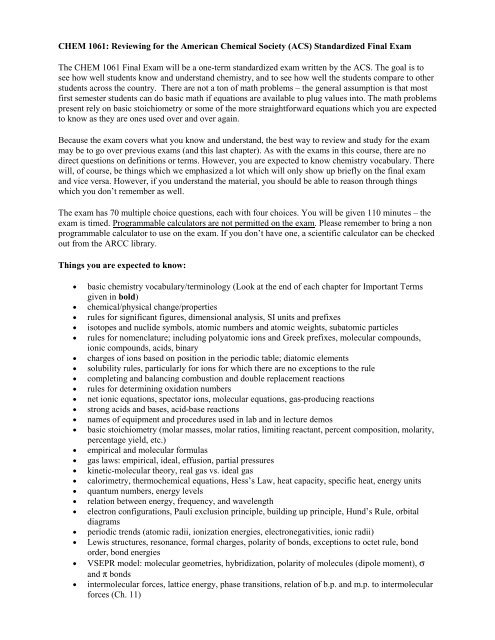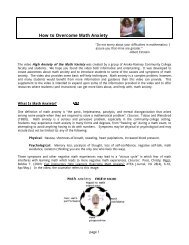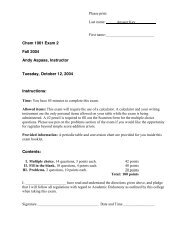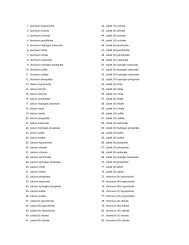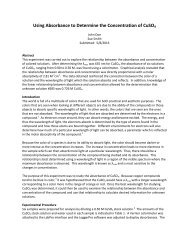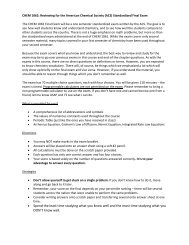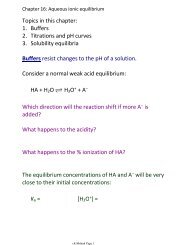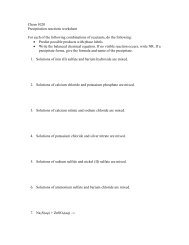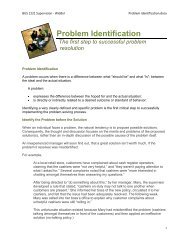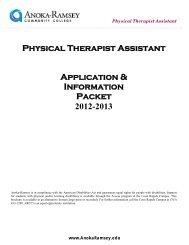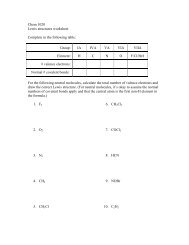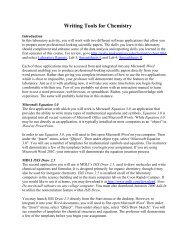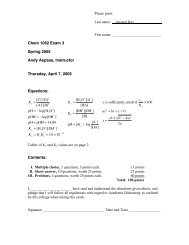Reviewing for ACS Final Exam - 1061_first_day
Reviewing for ACS Final Exam - 1061_first_day
Reviewing for ACS Final Exam - 1061_first_day
You also want an ePaper? Increase the reach of your titles
YUMPU automatically turns print PDFs into web optimized ePapers that Google loves.
CHEM <strong>1061</strong>: <strong>Reviewing</strong> <strong>for</strong> the American Chemical Society (<strong>ACS</strong>) Standardized <strong>Final</strong> <strong>Exam</strong>The CHEM <strong>1061</strong> <strong>Final</strong> <strong>Exam</strong> will be a one-term standardized exam written by the <strong>ACS</strong>. The goal is tosee how well students know and understand chemistry, and to see how well the students compare to otherstudents across the country. There are not a ton of math problems – the general assumption is that most<strong>first</strong> semester students can do basic math if equations are available to plug values into. The math problemspresent rely on basic stoichiometry or some of the more straight<strong>for</strong>ward equations which you are expectedto know as they are ones used over and over again.Because the exam covers what you know and understand, the best way to review and study <strong>for</strong> the exammay be to go over previous exams (and this last chapter). As with the exams in this course, there are nodirect questions on definitions or terms. However, you are expected to know chemistry vocabulary. Therewill, of course, be things which we emphasized a lot which will only show up briefly on the final examand vice versa. However, if you understand the material, you should be able to reason through thingswhich you don’t remember as well.The exam has 70 multiple choice questions, each with four choices. You will be given 110 minutes – theexam is timed. Programmable calculators are not permitted on the exam. Please remember to bring a nonprogrammable calculator to use on the exam. If you don’t have one, a scientific calculator can be checkedout from the ARCC library.Things you are expected to know:• basic chemistry vocabulary/terminology (Look at the end of each chapter <strong>for</strong> Important Termsgiven in bold)• chemical/physical change/properties• rules <strong>for</strong> significant figures, dimensional analysis, SI units and prefixes• isotopes and nuclide symbols, atomic numbers and atomic weights, subatomic particles• rules <strong>for</strong> nomenclature; including polyatomic ions and Greek prefixes, molecular compounds,ionic compounds, acids, binary• charges of ions based on position in the periodic table; diatomic elements• solubility rules, particularly <strong>for</strong> ions <strong>for</strong> which there are no exceptions to the rule• completing and balancing combustion and double replacement reactions• rules <strong>for</strong> determining oxidation numbers• net ionic equations, spectator ions, molecular equations, gas-producing reactions• strong acids and bases, acid-base reactions• names of equipment and procedures used in lab and in lecture demos• basic stoichiometry (molar masses, molar ratios, limiting reactant, percent composition, molarity,percentage yield, etc.)• empirical and molecular <strong>for</strong>mulas• gas laws: empirical, ideal, effusion, partial pressures• kinetic-molecular theory, real gas vs. ideal gas• calorimetry, thermochemical equations, Hess’s Law, heat capacity, specific heat, energy units• quantum numbers, energy levels• relation between energy, frequency, and wavelength• electron configurations, Pauli exclusion principle, building up principle, Hund’s Rule, orbitaldiagrams• periodic trends (atomic radii, ionization energies, electronegativities, ionic radii)• Lewis structures, resonance, <strong>for</strong>mal charges, polarity of bonds, exceptions to octet rule, bondorder, bond energies• VSEPR model: molecular geometries, hybridization, polarity of molecules (dipole moment), σand π bonds• intermolecular <strong>for</strong>ces, lattice energy, phase transitions, relation of b.p. and m.p. to intermolecular<strong>for</strong>ces (Ch. 11)
• g/cm 3 may be written as g·cm -3 L ⋅ atm;mol ⋅ K• The following equations:-1may be written as L·atm·mol-1·Kmd = ∆Hº = Σn∆Hº f (products) - Σn∆Hº f (reactants)VM 1 V 1 = M 2 V 2different concentrations (M, %, etc)PV = nRTPV 1T11=P2VT22q = m×s×∆Tq (system) = -q (surroundings)What is provided <strong>for</strong> you?• A comprehensive list of abbreviations and symbols• The values of numerous constants used throughout the course• Periodic Table (just like the ones you have received in class)Directions• You may NOT make marks in the exam booklet.• Answers will be placed onto an answer sheet using a soft #2 pencil.• All calculations must be done on the scratch paper provided.• Each question has only one correct answer and has four choices.• Your score is based solely on the number of questions answered correctly. It is to youradvantage to answer every question.Strategies• Don’t allow yourself to get stuck on a single problem. If you don’t know how to do it, movealong and go back to it later.• Remember, your score on the final depends on your percentile ranking – there will be severalstudents that were unable to do the same problems.• Consider writing answers onto scratch paper and transferring several onto answer sheet at onetime.• Spend the least time studying what you know well and the most time studying what you DON’Tknow well.


